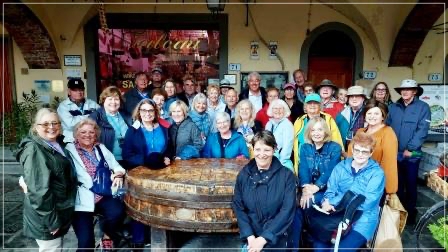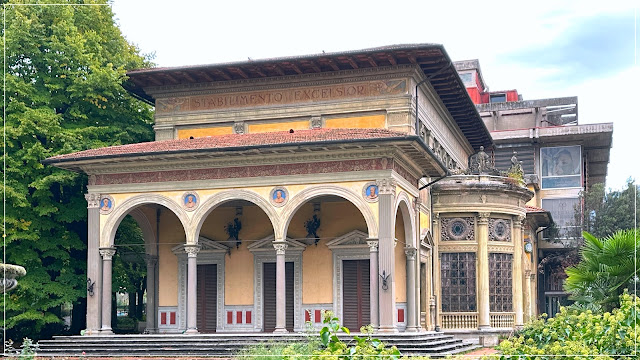Why is this name included in the Addams Family films we watched this week?
That's what I wanted to know; after reading this post, you will too.
In keeping with our usual tradition, we've been watching movies associated with this time of year. The above question is connected to a couple of popular films.
What have we watched?
Thanks for asking, here's what we will have finished watching by the end of this week.
Films are listed in order of their release with the type included.
- It's the Great Pumpkin, Charlie Brown (1966 animation)
- Death Becomes Her (1982 comedy/fantasy
- Ghostbusters (1984 comedy/supernatural)
- The Witches of Eastwick (1987 comedy/horror)
- Beetlejuice (1988 comedy/horror)
- Ghostbusters II (1989 comedy/supernatural
- The Addams Family (1991 comedy)
- The Addams Family Values (1993 comedy)
- Hocus Pocus (1993 comedy)
- Practical Magic (1998 comedy/fantasy)
We're not fans of horror films and these types are not on our viewing list. The two films listed above as comedy/horror had somewhat more comedy than horror.
If you plan to watch The Witches of Eastwick one day, be forewarned that it's a dark film, some and some scenes especially at the film's end were horror-ible in the horrifying sense.
This was one of our least favorite films, the other was Hocus Pocus, in which the Sanderson sister witches were just plain mean-spirited. Our annual favorites include The Addams Family, Beetlejuice and Charlie Brown.
But, I digress, which is nothing new.
What about the post title?
I don't know about any of you, but I always read the film credits and sometimes there is an interesting bit. For example, in both of the Addams family films, there is a credit line in the opening and closing credits that reads: Thank you to Lady Colyton. (While I never watched the TV shows, I read that they do not mention the name there.)
Curious about this person, I did some online research. Read on for the rest of the story to learn more about who created these pop culture characters.
That would be American cartoonist Charles Addams, who became known for these darkly humorous and macabre characters known as the Addams Family. (Addams was born and raised in our home state of NJ in Westfield, where I attended school. Who knew?)
If you've never seen them in illustrations, movies or on TV, the Addams family are an eccentric old-money clan who delight in the macabre, unconcerned that others find them odd. Family members were unnamed until the 1960s. That changed in 1962, when matriarch Morticia and daughter Wednesday were named after a licensed doll collection was released; patriarch Gomez and son Pugsley were named when the 1964 television series debuted. The Addams Family consists of Gomez and Morticia Addams, Wednesday and Pugsley, family members Uncle Fester and Grandmama and their butler Lurch. Pubert Addams, an infant brother, was introduced in the 1993 film.
 |
| Charles Addams and one of his illustrations |
Addams drawings ran in The New Yorker magazine starting in 1938 and ran regularly until his death in 1988. Addams did not work at magazine's offices. He was a freelancer who went there to drop off his illustrations. The “Addams family” characters originally did not have names, and sometimes the cartoons did not even have captions.
 |
| Charles Addams & second wife |
In 1943, Addams married his first wife Barbara Jean Day. They divorced 8 years later; she wanted children, he did not. In 1954, he wed Estelle B. Barb (who ironically went by the name Barbara). The marriage was tumultuous by many accounts with the couple arguing over money and the legacy of Addams' creations. The pair were married for two years and divorced in 1956.
A practicing lawyer, the second Mrs. Addams was reported to combined Morticia-like looks with diabolical legal scheming. She secured the rights to the Addams Family TV and film franchises and persuaded her husband to give away other legal rights in their divorce settlement. When the TV show became a hit in 1964, she received 10 percent of Addams’ royalties.
At one point, she persuaded him to take out a $100,000 insurance policy.She was not the inspiration for Morticia Addams as she married the cartoonist years after the then unnamed goth icon made her first appearances in The New Yorker.
Her royal name came later
Shortly after she and Addams divorced, the former Mrs Addams didn't waste time. She remarried the same year her divorce was finalized, this time to Henry Hopkinson, a British diplomat and 1st Baron Colyton, known as Lord Colyton.
Lady Colyton benefitted from her short union with Addams. A practicing lawyer, she had continued to serve as his attorney and agent after their divorce and then later would receive royalties from the extremely lucrative Addams franchise.
Unfortunately, Charles Addams didn't live to see the massive popularity that his works became with the release of the 1991 and 1993 films. He died on 1988 in NYC at the age of 76 after suffering a heart attack in his car. His native state honored him when Addams was inducted into the New Jersey Hall of Fame in 2020.
Lady Colyton was widowed when Lord Colyton died in 1996. She outlived both husbands and died in 2004.
Since 2017, Westfield, NJ, Addams home town, has hosted AddamsFest. This town-wide event is held throughout October, with family-friendly events, lectures, exhibits and more. Maybe, one future Halloween season we'll make a return trip to NJ for the celebrations.
Today is Halloween, so in keeping with the date, here's a sampling of decorations outside the apartments of residents in the mill apartments. Children who live in the building will trick or treat only knocking at doors which display a hang tag indicating the resident's participation.
As for ourselves, we will not home on Halloween. We're spending an overnight in VT after a shopping excursion to the Vermont Teddy Bear Factory (photos in a future post). |
| We hope your Halloween doesn't have unexpected tricks or surprises |
Your turn — do you have any Halloween traditions or planned events for today ?



















































